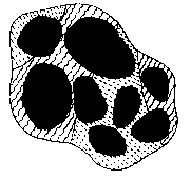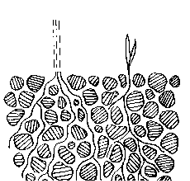
Check your soil structure

Soil is composed of sand, silt, clay and organic matter. The minute particles of sand and silt are bound by clay and organic matter into aggregates. These are the crumbs or lumps soil breaks into when you dig it. The technical term for them is peds.
The arrangement of aggregates gives soil its structure. Good soil structure has adequate spaces (pores) between aggregates to allow water and air to enter the soil and drain easily, while holding enough moisture to maintain plant growth. Poor soil structure has few aggregates and few pores between soil particles.
Digging
Digging a small hole 20–30cm deep will give you some idea of the structure and strength of your topsoil, although dry soils are often hard and not necessarily poorly structured. Dig the hole, take a slice off the side and carefully lift it out so it stays intact. Lay the slice on its side to examine it. A crumbly soil is usually softer and more encouraging to root and shoot development than a massive soil where soil particles are all the same size (such as fine silt), or cloddy soil which breaks apart into large clods and is difficult to break down further, or platey soil which breaks into flat plate-like layers (such as soil crusts).
Porosity

Examine the spadeful of soil closely for channels created by earthworms, ants, old plant roots and crack lines. These are very important features of a well-structured soil as they allow easy root penetration and water and air flow.
Composition
This exercise illustrates the proportions of gravel, sand, silt and clay in your soil.
- Place a cup of dry topsoil or subsoil in a 20-cm container (for example, a cordial bottle), fill with clean water and shake vigorously for a few minutes.
- Stand the bottle upright and watch carefully as the soil particles settle in the following order: gravel, sand, silt, clay. Most particles settle within five minutes. Some aggregates are so strong they will not break into particles and can be seen as lumps at the bottom.
- Any particles which have not settled after eight hours are clays which have dispersed. The individual clay particles move freely in water and do not clump together.
Texture
The combination of sand, silt and clay gives soil its texture. There are 19 soil textures, ranging from sand through loam to heavy clay. The following test helps you assess the texture of your soil.
- Take a small handful of topsoil or subsoil and remove any gravel, stones, leaves and twigs. Break up any aggregates.
- Adding a drop of water at a time, knead the soil in your palms to make a small ball about 4 cm in diameter. Stop adding water as soon as the ball starts to stick to your hand, and knead for another 30 seconds. You will find it almost impossible to mould a ball with very sandy soil, and much easier with a clay soil.
- Press the ball between your fingers to determine its texture. A gritty feel indicates fine and coarse sand. (You can hear the sand grinding if you hold the ball to your ear.) A silky feel indicates silt, and a plastic, sticky feel indicates clay.
- You can also determine texture by making a soil ribbon. Press the ball between your thumb and forefinger. The longer the ribbon, the more clay is in your soil.
Dispersibility and slaking
It is important to test for dispersibility and slaking if you plan to clear land for cultivation or build earthworks. In dispersible soils, moist or wet clay breaks up into individual clay particles due to a chemical reaction between water and sodium in the clay. These particles block the soil pores and seal the soil surface. This is good for dam building, but not for pastures or crops, because water and roots will have difficulty penetrating the soil.
Slaking occurs in poorly structured soils when dry soil is wet rapidly. Water moves into the pores and forces air out. The force of the escaping air causes the aggregate to burst and break down into smaller particles. These wash into the soil and block soil pores, and form a crust on the soil surface.
- Drop a few pea-sized air-dry aggregates into a dish of rainwater or irrigation water.
- Observe immediately, and after 10 minutes, then leave undisturbed for two hours.
- If the water around the aggregates becomes cloudy it means the clay in the aggregate has separated into individual particles and dispersion has occurred.
- If the aggregates crumble into smaller fragments in the first 10 minutes, there is not enough organic matter to hold them together, and the soil is said to have slaked.
- If the aggregates remain intact, there is enough organic matter to keep them together, so conditions are excellent for plant growth. The pores will remain open after wetting and water will drain quickly. Roots will penetrate easily and there will be no hard crust on drying.
Plasticity
This test helps you decide if your soil is too wet for vehicle/animal traffic or cultivation.
Rapidly squeeze a small lump of soil into a ball and attempt to roll it into a 3-mm diameter rod. If you can make a cohesive rod easily the soil is too wet and should not be worked with machinery. If you cannot make a rod at all, then it is only suitable to cultivate if it is a clay soil; if it is a loam, this indicates the soil is too dry to cultivate. If you can just make a crumbly rod, the water content should be right for cultivating all soil types.
From the Soil Sense leaflet 9/92. Agdex 504 produced by Rebecca Lines-Kelly, formerly soils media officer, Wollongbar Agricultural Institute, for CaLM and NSW Agriculture, north coast region, under the National Landcare Program, October 1992.

